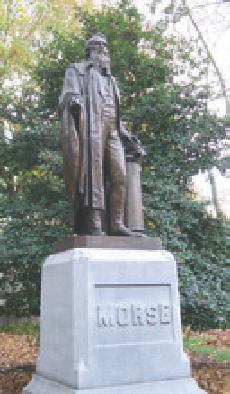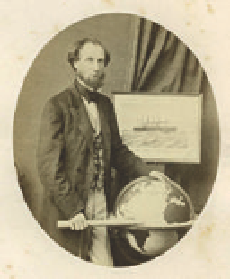Information Technology Reference
In-Depth Information
the telegraph network expanded rapidly in both countries. By 1850, there were
more than two thousand miles of wire in the United Kingdom and more than
twelve thousand miles in the United States. In 1852, the first underwater cable
linking London and Paris was laid across the English Channel. In the United
States, the idea of a transatlantic cable had been suggested by Morse in the
1840s but the idea was thought to be impractical. In 1854, the wealthy busi-
nessman Cyrus Field (
B.10.6
) took up the idea and had a cable laid from New
York to St. John's in Newfoundland, preparing to extend the cable across the
Atlantic Ocean to Ireland (
Fig. 10.5
). Field persuaded both the U.S. and British
governments to back the project, and the first undersea connection was estab-
lished in August 1858 (
Fig. 10.6
). Queen Victoria sent the first transatlantic mes-
sage to U.S. President James Buchanan.
Unfortunately, the engineer in charge of the project, Edward Whitehouse,
had very little understanding of the science of underwater telegraphy. Within
a month, the cable had failed. A joint government inquiry was set up to deter-
mine the reasons for the failure. It was William Thomson, then a physics pro-
fessor at Glasgow University, later to become Lord Kelvin, who put submarine
telegraphy on a sound scientific foundation. Thomson's understanding of the
relevant physics was confirmed by the successful laying of an undersea cable
through the Persian Gulf in 1864, connecting Europe to India. One of the key
technologies for undersea cables was the use of a rubbery gum called
gutta-per-
cha
, obtained from a tree grown in Southeast Asia, to coat and protect the cables
(
Fig. 10.7
). The London-based Gutta Percha Company suddenly found itself with
a virtual monopoly on the production of submarine cables. The Gutta Percha
Company eventually became part of Cable & Wireless Worldwide.
The telegraph system was an early example of a
store-and-forward
network,
in which messages were sent to an intermediate station before they were
transmitted to their destination. Telegraph services routed signals through
intermediate relay stations because electrical losses from telegraph wires
accumulated and degraded a message if it had to travel over long distances.
Intermediate stations received messages as dots and dashes of Morse code and
recorded them on punched paper tape. Incoming messages were separated
from each other by tearing the tape in the appropriate places, which led to
the intermediate stations being called “torn-tape relay centers.” A telegraph
operator at the receiving station read the destination on the message tape
Fig. 10.5. Memorial in Telegraph Field,
Valentia Island, Ireland, commemorating
the site of the European end of the first
transatlantic cable in 1858.
B.10.5. Photograph of the statue
of Samuel F. B. Morse (1791-1872),
pioneer of the telegraph and inventor
of Morse code, in New York's Central
Park. The statue was dedicated in 1871.
B.10.6. Cyrus Field (1819-92) began work at age fifteen as an office boy for A. T. Stewart &
Co., New York City's first department store. By the age of twenty, he was a partner in a paper
manufacturing company, and at thirty-three was able to retire as a wealthy man. In 1854, Field
became enthusiastic about the possibility of laying an undersea transatlantic telegraph cable
from Newfoundland to Ireland. After several failed attempts, in August 1858 Field arranged for
Queen Victoria to send the first transatlantic message to President James Buchanan, and there
were great celebrations on both sides of the Atlantic. The cable and the project were not success-
fully completed until 1866. In the portrait, Field is seen touching a globe and holding a length of
cable wire.




Search WWH ::

Custom Search